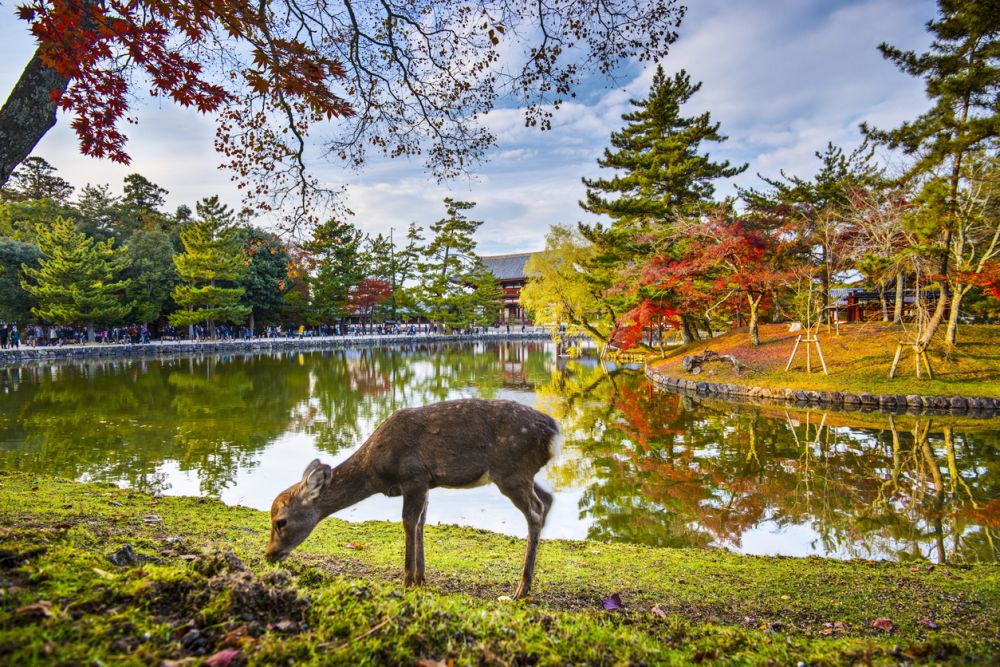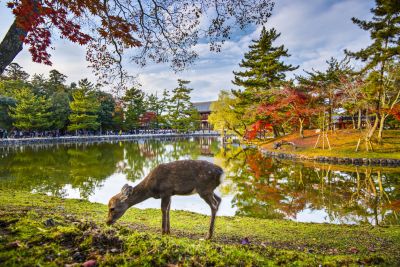

A visit to the Todai-ji Temple, a UNESCO World Heritage Site, is a journey through history and spirituality. Constructed in the 8th century, it houses the Great Buddha (Daibutsu), a colossal bronze statue that stands at about 15 meters tall. Exploring the temple grounds allows visitors to appreciate ancient Japanese wooden architecture, as Todai-ji's Great Buddha Hall is one of the largest wooden structures in the world. The temple complex is surrounded by beautiful gardens and wildlife, including deer that roam freely and are considered to be sacred messengers of the gods in the Shinto religion. Guests often purchase 'shika senbei' (deer crackers) to feed the deer, adding a unique and interactive element to their visit. Todai-ji Temple is not just a historic monument but also a vibrant center of cultural activity, with regular events and ceremonies taking place throughout the year that showcase the living traditions of Japanese Buddhism.
Nara Deer Park is a public park and a must-visit attraction in Nara, known for its hundreds of freely roaming deer. Considered to be the messengers of the gods in Shinto, these tame creatures are a symbol of the city and add a mystical aura to the park's environment. Visitors can interact with the deer and feed them special crackers sold around the park. While the deer are the main draw, the park itself is steeped in natural beauty with lush greenery, traditional lanterns, and serene ponds. Seasonal changes offer different experiences, from cherry blossoms in spring to colorful foliage in autumn. Within this picturesque landscape are various historically significant temples and shrines, making it an excellent place for both nature lovers and cultural enthusiasts. Exploring Nara Deer Park is an engaging way to spend a day and immerse oneself in the wildlife and culture that make Nara so special.
Kasuga-taisha, established in the 8th century, is Nara's most celebrated shrine and is famous for its lanterns that have been donated by worshippers. Hundreds of bronze lanterns can be seen hanging from the buildings, while as many stone lanterns line its approach and pathways. The effect is especially magical during lantern festivals, such as the Setsubun Mantoro and Obon Mantoro, when all lanterns are lit up, creating an enchanting atmosphere. Visitors to Kasuga-taisha can enjoy the vermilion-colored structures contrasting beautifully with the surrounding greenery, making it a picturesque location year-round. Additionally, the shrine complex includes auxiliary shrines, treasure houses, and a botanical garden, offering guests a comprehensive cultural experience. Walking through Kasuga-taisha's peaceful environment, visitors can partake in Shinto practices such as buying charms for good fortune or participating in traditional rituals.
Mount Wakakusa is a grass-covered mountain located behind Nara Park, offering a relatively easy hike for visitors. The 342-meter tall hill provides a panoramic view of Nara city and its surrounding areas, including a distant glimpse of Kyoto on clear days. The hike typically starts from the foot of the hill near Kasuga-taisha and winds through gentle slopes covered with seasonal wildflowers and grass. This activity is particularly popular in January during the Wakakusa Yamayaki, an annual festival where the hill's grass is set on fire in a controlled event accompanied by fireworks. The charred landscape left behind soon regenerates, symbolizing rebirth and new growth. Hiking Mount Wakakusa provides a refreshing break from the temple visits, allowing travelers to immerse themselves in nature while experiencing sweeping views and the serene ambiance of the Nara countryside.
The Nara National Museum, nestled in Nara Park, offers a profound exploration of Japan's rich artistic heritage, focusing on Buddhist art. Visitors can explore extensive collections of sculptures, paintings, scrolls, and ceremonial objects that provide a glimpse into the evolution of Buddhist art in Japan. Most notable is the annual Shoso-in Exhibition, which displays rare artifacts related to Emperor Shomu and the Todai-ji Temple. The museum's architecture itself is a blend of historical and modern, with the original building showcasing Meiji-era design and a newer wing offering a contemporary aesthetic. Through its permanent and special exhibitions, the Nara National Museum serves as a gateway to understanding ancient Japanese culture and the religious influences that shaped it. Informative displays and educational programs make this museum a captivating experience for history buffs, art lovers, and curious travelers alike.
